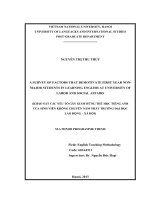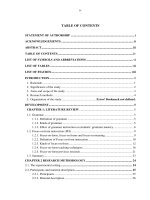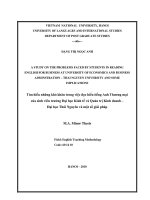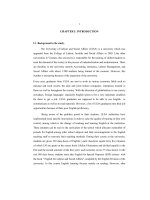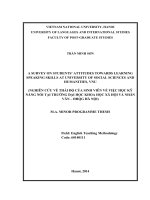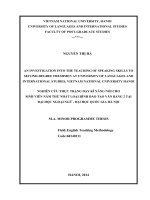chap70 pps Automotive technology at University of Cambridge
Bạn đang xem bản rút gọn của tài liệu. Xem và tải ngay bản đầy đủ của tài liệu tại đây (1.44 MB, 53 trang )
start
Automotive Technology: Principles, Diagnosis, and Service, 3rd Edition
By James D. Halderman
©©2008
2009Pearson
PearsonEducation,
Education,Inc.
Inc.
Pearson
PearsonPrentice
PrenticeHall
Hall- -Upper
UpperSaddle
SaddleRiver,
River,NJ
NJ07458
07458
OBJECTIVES:
After studying Chapter 70, the reader should
be able to:
•
•
•
Prepare for ASE Brakes (A5) certification test
content area “A” (Hydraulic System Diagnosis
and Repair).
Describe the operation of a residual check
valve.
Explain how a proportioning valve works.
Continued
Automotive Technology: Principles, Diagnosis, and Service, 3rd Edition
By James D. Halderman
©©2008
2009Pearson
PearsonEducation,
Education,Inc.
Inc.
Pearson
PearsonPrentice
PrenticeHall
Hall- -Upper
UpperSaddle
SaddleRiver,
River,NJ
NJ07458
07458
OBJECTIVES:
After studying Chapter 70, the reader should
be able to:
•
•
•
Discuss the need and use of a metering valve.
List testing procedures used to test hydraulic
valves.
Describe how the brake fluid level and brake
light switches work.
Automotive Technology: Principles, Diagnosis, and Service, 3rd Edition
By James D. Halderman
©©2008
2009Pearson
PearsonEducation,
Education,Inc.
Inc.
Pearson
PearsonPrentice
PrenticeHall
Hall- -Upper
UpperSaddle
SaddleRiver,
River,NJ
NJ07458
07458
KEY TERMS:
brake fluid level sensor • brake light switch
combination valve
electronic brake proportioning • expander
height-sensing proportioning valve
metering valve
pressure-differential switch • proportioning valve
residual check valve • slope • split point
Automotive Technology: Principles, Diagnosis, and Service, 3rd Edition
By James D. Halderman
©©2008
2009Pearson
PearsonEducation,
Education,Inc.
Inc.
Pearson
PearsonPrentice
PrenticeHall
Hall- -Upper
UpperSaddle
SaddleRiver,
River,NJ
NJ07458
07458
RESIDUAL CHECK VALVE
A residual check valve has been used on some drum brake
systems to keep a slight amount of pressure on the entire
hydraulic system for drum brakes (5 to 12 psi).
The check valve is located in the master cylinder at the outlet for
the drum brakes.
The ball and spring in the
check valve permit all the
brake fluid to return to the
master cylinder until the
designated pressure is
reached.
Figure 70–1 Most residual check valves are
located under the tubing seals in the master
cylinder outlet ports.
Automotive Technology: Principles, Diagnosis, and Service, 3rd Edition
By James D. Halderman
Continued
©©2008
2009Pearson
PearsonEducation,
Education,Inc.
Inc.
Pearson
PearsonPrentice
PrenticeHall
Hall- -Upper
UpperSaddle
SaddleRiver,
River,NJ
NJ07458
07458
This slight pressure prevents air leaks from entering into the
hydraulic system in the event of a small hole or leak.
With a low pressure kept on the hydraulic system, any small hole
will cause fluid to leak out rather than permit air to enter the
system.
This slight pressure also keeps the wheel cylinder sealing cups
tight against the inside wall of the wheel cylinder.
See Figure 70–2.
Continued
Automotive Technology: Principles, Diagnosis, and Service, 3rd Edition
By James D. Halderman
©©2008
2009Pearson
PearsonEducation,
Education,Inc.
Inc.
Pearson
PearsonPrentice
PrenticeHall
Hall- -Upper
UpperSaddle
SaddleRiver,
River,NJ
NJ07458
07458
Figure 70–2 The momentary drop in pressure created when the brakes are released can draw
air into the hydraulic system.
Continued
Automotive Technology: Principles, Diagnosis, and Service, 3rd Edition
By James D. Halderman
©©2008
2009Pearson
PearsonEducation,
Education,Inc.
Inc.
Pearson
PearsonPrentice
PrenticeHall
Hall- -Upper
UpperSaddle
SaddleRiver,
River,NJ
NJ07458
07458
Residual check valves are often not used on late model vehicles
equipped with front disc/rear drum brakes.
The residual check valve has been eliminated by equipping the
wheel cylinder internal spring with a sealing cup expander to
prevent sealing cup lip collapse.
Figure 70–3 The use of cup expanders is the main reason why residual check valves are not
used in most braking systems today.
Automotive Technology: Principles, Diagnosis, and Service, 3rd Edition
By James D. Halderman
©©2008
2009Pearson
PearsonEducation,
Education,Inc.
Inc.
Pearson
PearsonPrentice
PrenticeHall
Hall- -Upper
UpperSaddle
SaddleRiver,
River,NJ
NJ07458
07458
PRESSURE-DIFFERENTIAL SWITCH
(BRAKE WARNING SWITCH)
A pressuredifferential switch is used on all vehicles built after
1967 with dual master cylinders to warn the driver of a loss of
pressure in one of the two separate systems by lighting the
dashboard red brake warning indicator lamp.
The brake lines from both front
and rear sections of the master
cylinder are sent to this switch
Figure 70–4 A red brake warning lamp.
It lights the brake warning
indicator lamp in the event
of a “difference in pressure.”
See Figure 70–5.
Continued
Automotive Technology: Principles, Diagnosis, and Service, 3rd Edition
By James D. Halderman
©©2008
2009Pearson
PearsonEducation,
Education,Inc.
Inc.
Pearson
PearsonPrentice
PrenticeHall
Hall- -Upper
UpperSaddle
SaddleRiver,
River,NJ
NJ07458
07458
Figure 70–5 A leak in the hydraulic system causes unequal pressures between the two different
brake circuits. This difference in pressures causes the plunger inside the pressure-differential
switch to move, which completes the electrical circuit for the red brake warning lamp. (Courtesy
of Ford Motor Company)
If the lamp
remains on:
1. Apply light
pressure to
the brake pedal.
2. Momentarily
open the bleeder
valve on the side
that did not fail.
Continued
Automotive Technology: Principles, Diagnosis, and Service, 3rd Edition
By James D. Halderman
©©2008
2009Pearson
PearsonEducation,
Education,Inc.
Inc.
Pearson
PearsonPrentice
PrenticeHall
Hall- -Upper
UpperSaddle
SaddleRiver,
River,NJ
NJ07458
07458
Those procedures should center the pressuredifferential switch
valve in those vehicles that are not equipped with selfcentering
springs.
Figure 70–6 The pressure-differential switch piston is used to provide the electrical ground for
the red brake warning light circuit.
Automotive Technology: Principles, Diagnosis, and Service, 3rd Edition
By James D. Halderman
©©2008
2009Pearson
PearsonEducation,
Education,Inc.
Inc.
Pearson
PearsonPrentice
PrenticeHall
Hall- -Upper
UpperSaddle
SaddleRiver,
River,NJ
NJ07458
07458
BRAKE FLUID LEVEL SENSOR SWITCH
Many master cylinders, especially systems that are a diagonal
split, usually use a brake fluid level sensor or switch in the
master cylinder reservoir.
This sensor will light the red “brake” warning lamp on the dash if
low brake fluid level is detected. A floattype sensor or a
magnetic reed switch are commonly used and provide a complete
electrical circuit when the brake fluid level is low.
After refilling the master cylinder reservoir to the correct level,
the red “brake” warning lamp should go out.
See Figures 70–7 and 70–8.
Continued
Automotive Technology: Principles, Diagnosis, and Service, 3rd Edition
By James D. Halderman
©©2008
2009Pearson
PearsonEducation,
Education,Inc.
Inc.
Pearson
PearsonPrentice
PrenticeHall
Hall- -Upper
UpperSaddle
SaddleRiver,
River,NJ
NJ07458
07458
Figure 70–7
A movable contact brake fluid level switch.
Figure 70–8
A magnetic brake fluid level switch.
NOTE: Brake systems use either a pressuredifferential switch or a low
brake fluid switch to light the dash red “brake” lamp, but not both.
Automotive Technology: Principles, Diagnosis, and Service, 3rd Edition
By James D. Halderman
©©2008
2009Pearson
PearsonEducation,
Education,Inc.
Inc.
Pearson
PearsonPrentice
PrenticeHall
Hall- -Upper
UpperSaddle
SaddleRiver,
River,NJ
NJ07458
07458
DIAGNOSING A RED “BRAKE” DASH WARNING
LAMP
Activation of the red brake dash warning lamp can be for any one of
several reasons:
1. Parking Brake “On.” The same dash warning lamp is used to
warn the driver that the parking brake is on.
2. Low Brake Fluid. This lights the red dash warning lamp on
vehicles equipped with a master cylinder reservoir brake fluid
level switch.
3. Unequal Brake Pressure. The pressuredifferential switch is
used on most vehicles with a front/rear brake split system to
warn the driver whenever there is low brake pressure to either
the front or rear brakes.
Continued
Automotive Technology: Principles, Diagnosis, and Service, 3rd Edition
By James D. Halderman
©©2008
2009Pearson
PearsonEducation,
Education,Inc.
Inc.
Pearson
PearsonPrentice
PrenticeHall
Hall- -Upper
UpperSaddle
SaddleRiver,
River,NJ
NJ07458
07458
The likely cause of the red “brake” warning lamp is low brake
fluid caused by a leaking brake line, wheel cylinder, or caliper.
The first step is to determine the cause of the lamp being on, then
to repair the problem.
Step #1 Check the Level of the Brake Fluid If low, carefully
inspect entire hydraulic brake system for leaks; repair as necessary.
Step #2 Disconnect the Wire from the PressureDifferential
Switch If the lamp is still “on,” the problem is the parking brake
lever switch, or the wire going to the switch, shorted to ground.
If the red brake warning lamp is “off” after being disconnected
from the pressuredifferential switch, the problem is due to a
hydraulic failure (a low pressure in either front or rear system
creating a pressure difference of at least 150 psi).
Continued
Automotive Technology: Principles, Diagnosis, and Service, 3rd Edition
By James D. Halderman
©©2008
2009Pearson
PearsonEducation,
Education,Inc.
Inc.
Pearson
PearsonPrentice
PrenticeHall
Hall- -Upper
UpperSaddle
SaddleRiver,
River,NJ
NJ07458
07458
NOTE: Many Japanese vehicles energize the relay that turns off the red
“brake” warning lamp from the output terminal of the alternator. If a
quick inspection of the brake system seems to indicate that everything is
okay, check for correct charging voltage before continuing a more detailed
brake system inspection.
Automotive Technology: Principles, Diagnosis, and Service, 3rd Edition
By James D. Halderman
©©2008
2009Pearson
PearsonEducation,
Education,Inc.
Inc.
Pearson
PearsonPrentice
PrenticeHall
Hall- -Upper
UpperSaddle
SaddleRiver,
River,NJ
NJ07458
07458
PROPORTIONING VALVE
A proportioning valve improves brake balance during hard stops
by limiting hydraulic pressure to the rear brakes.
The valve is necessary because inertia creates weight shift toward
the front of the vehicle during braking. The shift unloads the rear
axle, which reduces traction between the tires and the road, and
limits the amount of stopping power that can be delivered.
Unless application pressure to the rear wheels is limited, the brakes
will lock, making the vehicle unstable and likely to spin. The best
overall braking performance is achieved when the front brakes lock
just before the rear brakes.
See Figure 70–9.
Continued
Automotive Technology: Principles, Diagnosis, and Service, 3rd Edition
By James D. Halderman
©©2008
2009Pearson
PearsonEducation,
Education,Inc.
Inc.
Pearson
PearsonPrentice
PrenticeHall
Hall- -Upper
UpperSaddle
SaddleRiver,
River,NJ
NJ07458
07458
Figure 70–9 Many proportioning valves are mounted directly to the master cylinder in the outlet
to the rear brakes.
Continued
Automotive Technology: Principles, Diagnosis, and Service, 3rd Edition
By James D. Halderman
©©2008
2009Pearson
PearsonEducation,
Education,Inc.
Inc.
Pearson
PearsonPrentice
PrenticeHall
Hall- -Upper
UpperSaddle
SaddleRiver,
River,NJ
NJ07458
07458
Vehicles with front disc and rear drum brakes require a proportioning
valve for two reasons:
1. Disc brakes require higher hydraulic pressure for a given
stop than do drum brakes. In a disc/drum system, the front
brakes always need more pressure than the rear brakes.
2. Once braking has begun, drum brakes require less pressure
to maintain a fixed level of stopping power than they did to
establish that level. In a disc/drum system, the rear brakes
will always need less pressure than the front brakes.
A proportioning valve is used to compensate for these differences
because it is easier to reduce pressure to the rear brakes than to
increase pressure to the front brakes.
Continued
Automotive Technology: Principles, Diagnosis, and Service, 3rd Edition
By James D. Halderman
©©2008
2009Pearson
PearsonEducation,
Education,Inc.
Inc.
Pearson
PearsonPrentice
PrenticeHall
Hall- -Upper
UpperSaddle
SaddleRiver,
River,NJ
NJ07458
07458
Figure 70–10 Typical proportioner valve pressure relationship. Note that, at low pressures, the
pressure is the same to the rear brakes as is applied to the front brakes. After the split point,
only a percentage (called the slope) of the master cylinder pressure is applied to the rear
brakes.
The proportioning valve does
not work at all times.
During light or moderate
braking, there is no rear
wheel locking a problem.
Before proportioning will
begin, hydraulic pressure
must reach a level called
the split point.
Continued
Automotive Technology: Principles, Diagnosis, and Service, 3rd Edition
By James D. Halderman
©©2008
2009Pearson
PearsonEducation,
Education,Inc.
Inc.
Pearson
PearsonPrentice
PrenticeHall
Hall- -Upper
UpperSaddle
SaddleRiver,
River,NJ
NJ07458
07458
Figure 70–11 A Chrysler proportioning valve. Note that
slope and split point are stamped on the housing.
Above the split point,
the proportioning valve
allows only a portion of
the pressure through to
the rear brakes.
Figure 70–12 These two proportioning
valves are found under the vehicle on
this Dodge minivan.
Below the split point full
system pressure is supplied
to the rear brakes.
Continued
Automotive Technology: Principles, Diagnosis, and Service, 3rd Edition
By James D. Halderman
©©2008
2009Pearson
PearsonEducation,
Education,Inc.
Inc.
Pearson
PearsonPrentice
PrenticeHall
Hall- -Upper
UpperSaddle
SaddleRiver,
River,NJ
NJ07458
07458
Proportioning Valve Operation A simple proportioning valve
consists of a springloaded piston that slides in a stepped bore.
The piston is exposed to pressure on both sides. The smaller end of
the piston is acted on by pressure from the master cylinder, while the
larger end reacts to pressure in the rear brake circuit.
The actual proportioning valve is located in the center of the piston
and is opened or closed depending on the position of the piston in
the stepped bore.
See Figure 70–13.
Continued
Automotive Technology: Principles, Diagnosis, and Service, 3rd Edition
By James D. Halderman
©©2008
2009Pearson
PearsonEducation,
Education,Inc.
Inc.
Pearson
PearsonPrentice
PrenticeHall
Hall- -Upper
UpperSaddle
SaddleRiver,
River,NJ
NJ07458
07458
Figure 70–13 The proportioning valve piston can travel within the range shown without
reducing pressure to the rear brakes.
Continued
Automotive Technology: Principles, Diagnosis, and Service, 3rd Edition
By James D. Halderman
©©2008
2009Pearson
PearsonEducation,
Education,Inc.
Inc.
Pearson
PearsonPrentice
PrenticeHall
Hall- -Upper
UpperSaddle
SaddleRiver,
River,NJ
NJ07458
07458
When the brakes are first applied, hydraulic pressure passes
through the proportioning valve to the rear brakes.
Hydraulic pressure is the same on both sides of the piston, but
because the side facing the rear brakes has more surface area than
the side facing the master cylinder, greater force is developed and
the piston moves to the left against the spring tension.
At pressures below the split point, the proportioning valve is open,
and pressure to both the front and rear brakes is the same. As the
vehicle is braked harder, increased system pressure forces the
piston so far to the left that the proportioning valve is closed.
See Figure 70–14.
Continued
Automotive Technology: Principles, Diagnosis, and Service, 3rd Edition
By James D. Halderman
©©2008
2009Pearson
PearsonEducation,
Education,Inc.
Inc.
Pearson
PearsonPrentice
PrenticeHall
Hall- -Upper
UpperSaddle
SaddleRiver,
River,NJ
NJ07458
07458
Figure 70–14 At the split point, the proportioning valve piston closes the fluid passage
through the valve.
Continued
Automotive Technology: Principles, Diagnosis, and Service, 3rd Edition
By James D. Halderman
©©2008
2009Pearson
PearsonEducation,
Education,Inc.
Inc.
Pearson
PearsonPrentice
PrenticeHall
Hall- -Upper
UpperSaddle
SaddleRiver,
River,NJ
NJ07458
07458



